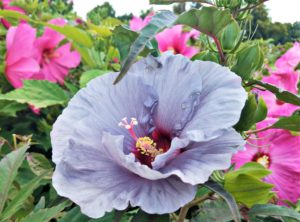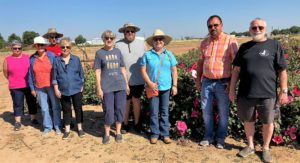Vernon hibiscus research draws public attention to AgriLife center

- Writer: Adam Russell, 903-834-6191, adam.russell@ag.tamu.edu
- Contact: Dr. Dariusz Malinowski, 940-552-9941, dmalinow@ag.tamu.edu
VERNON – The Texas A&M AgriLife Research and Extension Center in Vernon opened its hibiscus research plots to local Master Gardeners as a response to growing public interest in research activity there.
Dr. Dariusz Malinowski, Texas A&M AgriLife Research plant physiologist, Vernon, recently hosted a show-and-tell tour of the center’s research plots in Lockett for members of the Wichita County Master Gardeners Association.
Master Gardeners had visited the center for presentations, but it was the first time they toured the facility’s AgriLife Research hibiscus trial plots, he said. Vernon is the only location in Texas breeding new winter-hardy hibiscus varieties as part of a regular research program.
“They wanted to tour the trial garden and learn about winter-hardy hibiscus, our new flower colors and lines, and to find out what we do here and what our research goals are,” Malinowski said.

Malinowski said the program has typically evaluated 1,000 to 2,000 hybrid hibiscus varieties per year since it began in 2010. From those varieties, 20-30 hybrids may be chosen for disclosure to the Texas A&M Technology Commercialization office, which begins the commercialization process for potential new variety releases, based on their characteristics.
The hibiscus program in Vernon has disclosed 300 unique breeding lines since it began, Malinowski said.
“About eight of those, including the Summer Spice hibiscus series, were commercialized,” he said. “The process can take two to three years and then another two years to propagate the plants. It’s an interesting process.”
Malinowski said having the Master Gardeners tour the plots was a good opportunity to educate members about the process and the popular perennial plants that can be utilized in U.S. Department of Agriculture Zone 5 to 9, which ranges throughout the U.S. and much of Canada.
“They die back in the winter, but it’s related to day length, not freezing temperatures,” he said. “Once they’re established, they can tolerate drought because of their extensive root systems.”
Plants may not flower as well during drought years, Malinowski said, but they will survive on very little water.
The center and its programs have drawn more public attention in recent years. The city of Vernon has embraced the hibiscus program and is hoping to become the hibiscus capital of Texas, Malinowski said.
This year, the Vernon center donated around 600 seedlings to the city for planting in parks, at schools and churches to beautify the community, Malinowski said.
“There is a lot of interest from the community, and the hibiscus plants beautify the properties,” he said. “We’re here to serve a larger mission for industry and the public, but we’re also involved locally. The donation and our engagement with the city and our regional Master Gardeners are good examples of our center engaging with the community we call home.”


